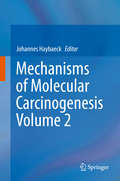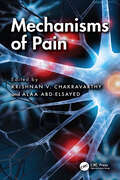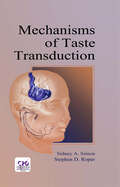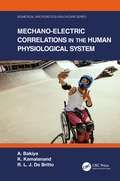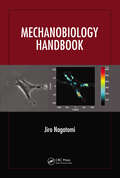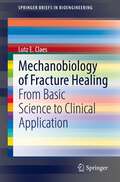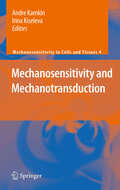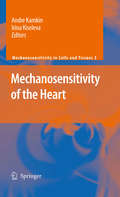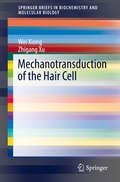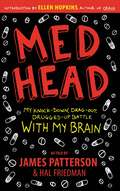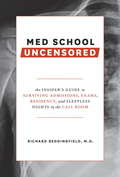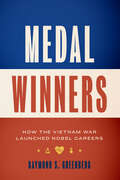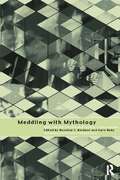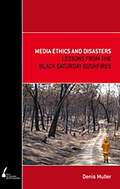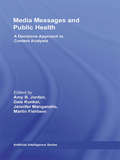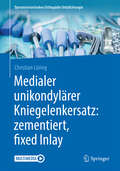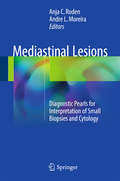- Table View
- List View
Mechanisms of Molecular Carcinogenesis – Volume 2
by Johannes HaybaeckTogether with Volume 1, this book provides an inclusive overview of the molecular and cellular mechanisms of carcinogenesis and offers comprehensive insights into related clinical and therapeutic aspects. This second volume complements the first by presenting and concisely explaining the carcinogenesis of various tumor entities such as non-melanoma skin cancers, bone and soft tissue tumors, pancreatic cancers, hepatocellular cancer and neuroendocrine tumors. As in volume one, each chapter illuminates the similarities and dissimilarities of changed signaling pathways in the different organ systems and depicts potential therapeutic strategies. The focus of volume two lies on the presentation of modern molecular biological techniques for diagnosis, as well as strategies for biomarker identification and validation. Furthermore, it discusses potential therapeutic targets and individualized treatment strategies, offering a valuable resource for all basic scientists and medical researchers interested in translational cancer research.
Mechanisms of Oncogenesis
by Domenico CoppolaThis volume is part of a book series that was first published in 10-volumes by Kluwer in 1989 under the series editorship of Professor Hans E. Kaiser, D.Sc., former Professor of Pathology at the School of Medicine, University of Maryland at Baltimore, MD, USA along with other leaders in the field of Cancer. In order to encompass the growing body of knowledge on various aspects of cancer growth and progression since then, the series has now been expanded to 17 volumes. This volume is a comprehensive update on the mechanisms of tumorigenesis, and includes the advances in the field, as provided by the use of the most recent molecular techniques (microarray, proteomic, and other omics). While the first portion of the book contains chapters discussing pediatric cancer, the influence of environmental factors and oncogene activity in tumorigenesis, the second portion of the book is structured by organ sites (Esophagus, Breast, Pancreas, Colon, Lung, Prostate, Skin, Brain, Endocrine System, Lymphoid System, Bone, Head and Neck, and Cervix). This format provides the reader with easy access to the needed information. This definitive text will offer the medical professionals, whether in research, academia or clinical practice, the latest information endorsed by the world renowned contributors. The broad range of topics will make this a valued reference and provide a wealth of information, making this a "state of the science" on carcinogenesis.
Mechanisms of Pain
by Alaa Abd-Elsayed Krishnan V. ChakravarthyPain is a serious health problem. This book presents an intensive review of the anatomy, physiology, and pharmacology of the systems that mediate nociceptive processing. The authors cover areas that include anatomy, central and peripheral nerve processing, tissue and nerve injury states, as well as preclinical and clinical models of pain. Mechanisms of Pain also covers important clinical concepts, with specific emphasis on mechanisms of action. Written by world renowned global faculty, this book covers important areas of science required to understand pain medicine. Important topics covered include post–tissue and nerve injury pain states of primary afferents and the spinal cord. The authors also cover mechanisms of action of clinically relevant analgesics (opiates and non-opiates), psychological aspects of pain, pathophysiology of migraines, as well as the genetics of pain. This comprehensive book is to guide undergraduate, graduate, and clinicians in the field of pain medicine on important concepts related to the science and practice of pain.
Mechanisms of Taste Transduction
by Sidney A. Simon Stephen D. RoperMechanisms of Taste Transduction introduces a number of topics essential to a complete understanding of taste. These topics range from the control of food intake to the biophysical mechanisms of transduction and the design of food flavors in the food industry. The responses and organization of special sensory pathways are described in regard to the
Mechanisms of Vascular Disease: A Textbook for Vascular Specialists
by Robert FitridgeThis extensively revised third edition provides a practically applicable guide to the pathophysiology, assessment and management of vascular disorders encountered in vascular surgical practice. It features detailed information on the latest developments in the pathophysiology of conditions including atherosclerosis, multi-organ failure, limb compartment syndromes and Raynaud’s phenomenon in a clear easy to digest format. Disorders such as reperfusion injuries, vasculitides, and aortic dissection are covered. Furthermore, key topics in vascular and endovascular practice such as radiation biology and radiation safety are also detailed. Each chapter contains a set of learning objectives and key references, enabling the reader to quickly identify key points.Mechanisms of Vascular Disease: A Textbook for Vascular Specialists comprehensively covers a variety of common and unusual pathophysiologies encountered in vascular surgery, and is an ideal resource for both the trainee, and practicing clinical vascular surgeon seeking an up-to-date resource on the topic.
Mechano-Electric Correlations in the Human Physiological System (Biomedical and Robotics Healthcare)
by K. Kamalanand A. Bakiya R. L. De BrittoThe aim of Mechano-Electric Correlations in the Human Physiological System is to present the mechanical and electrical properties of human soft tissues and the mathematical models related to the evaluation of these properties in time, as well as their biomedical applications. This book also provides an overview of the bioelectric signals of soft tissues from various parts of the human body. In addition, this book presents the basic dielectric and viscoelastic characteristics of soft tissues, an introduction to the measurement and characteristics of bioelectric signals and their relationship with the mechanical activity, electromyography and the correlation of electromyograms with the muscle activity in normal and certain clinical conditions. The authors also present a case study on the effect of lymphatic filariasis on the mechanical and electrical activity of the muscle. Features: Explains the basics of electrical and mechanical properties of soft tissues in time and frequency domain along with the mathematical models of soft tissue mechanics Explores the correlation of electrical properties with the mechanical properties of biological soft tissues using computational techniques Provides a detailed introduction to electrophysiological signals along with the types, applications, properties, problems and associated mathematical models Explains the electromechanics of muscles using electromyography recordings from various muscles of the human physiological system Presents a case study on the effect of lymphatic filariasis on the mechanical and electrical activity of the muscle Mechano-Electric Correlations in the Human Physiological System is intended for biomedical engineers, researchers and medical scientists as well graduate and undergraduate students working on the mechanical properties of soft tissues.
Mechanobiology Handbook
by Jiro NagatomiMechanobiology-the study of the effects of mechanical environments on the biological processes of cells-has evolved from traditional biomechanics via the incorporation of strong elements of molecular and cell biology. Currently, a broad range of organ systems are being studied by surgeons, physicians, basic scientists, and engineers. These mechanob
Mechanobiology of Fracture Healing: From Basic Science to Clinical Application (SpringerBriefs in Bioengineering)
by Lutz E. ClaesThis book offers a summary of research on the biomechanics of fracture fixation and mechanobiology of fracture healing. The author, a known expert, provides an overview of the state of art, his own research together with that of his co-workers and collaborators; he describes the ideas and findings from the beginning of this research field in the 1960s up to the clinical consequences and applications of today. The book discusses the mechanobiology of fracture healing, illustrates the numerical methods that simulate fracture healing processes, and depicts specific research methods of experimental studies. Finally, it provides conclusions for the improvement of fracture treatment that will be of use in clinical applications nowadays. This book will be a valuable resource of knowledge for students and scientists in the field of bioengineering, experimental biology, and biomechanics, helping them to identify the correct conditions and analysis for their respective research and receive an understanding of the research field from its beginning until today. For experimental and clinical surgeons active in the field of fracture healing, this book will provide a useful historical overview over this translational research field.
Mechanosensing Biology
by Masaki NodaMechanical stress is vital to the functioning of the body, especially for tissues such as bone, muscle, heart, and vessels. It is well known that astronauts and bedridden patients suffer muscle and bone loss from lack of use. Even the heart, in pumping blood, causes mechanical stress to itself and to vascular tissue. With the loss of mechanical stress, homeostasis becomes impaired and leads to pathological conditions such as osteopenia, muscle atrophy, and vascular tissue dysfunction. In elderly populations, such mechanical pathophysiology, as well as the mechanical activities of locomotor and cardiovascular systems, is important because skeletal and heart functions decline and cause diseases in other organs. In this monograph, mechanical stress is discussed by experts in the field with respect to molecular, cellular, and tissue aspects in relation to medicine. Covering topics such as gravity and tissues and disuse osteoporosis, the book provides the most up-to-date information on cutting-edge advancements in the field of mechanobiology and is a timely contribution to research into locomotor and circulatory diseases that are major problems in contemporary society.
Mechanosensitivity and Mechanotransduction
by Irina Kiseleva Andre KamkinThis book presents the latest findings in the field of research of mechanosensitivity and mechanotransduction in different cells and tissues. Mechanosensitivity and mechanotransduction of the heart and vascular cells, in the lung, in bone and joint tissues, in sensor systems and in blood cells are described in detail. This Volume focuses on molecular mechanisms of mechanosensitivity and mechanotransduction via cytoskeleton. Integrin-mediated mechanotransduction, the role of actin cytoskeleton and the role of other cytoskeletal elements are discussed. It contains a detailed description of several stretch-induced signaling cascades with multiple levels of crosstalk between different pathways. It contains a description of the role of nitric oxide in regulation of cardiac activity and in regulation of mechanically gated channels in the heart. In the heart mechanical signals are propagated into the intracellular space primarily via integrin-linked complexes, and are subsequently transmitted from cell to cell via paracrine signaling. Biochemical signals derived from mechanical stimuli activate both acute phosphorylation of signaling cascades, such as in the PI3K, FAK, and ILK pathways, and long-term morphological modii cations via intracellular cytoskeletal reorganization and extracellular matrix remodelling. Cellular and molecular effects of mechanical stretch on vascular cells are also discussed. This Volume highlights the role of mechanotransduction in the lung, in bone and joint tissues. For the first time mechanosensitivity and mechanotransduction in blood cells are discussed. It contains new insights into mechanosensitive K+ channels functioning in mouse B lymphocytes. This book is a unique collection of reviews outlining current knowledge and future developments in this rapidly growing field. Currently, investigations of the molecular mechanisms of mechanosensitivity and mechanotransduction are focused on several issues. The majority of studies investigate intracellular signaling pathways. Knowledge of the mechanisms which underlie these processes is necessary for understanding of the normal functioning of different organs and tissues and allows to predict changes, which arise due to alterations of their environment. Possibly such knowledge will allow the development of new methods of artificial intervention and therapies. This book brings up the problem closer to the experts in related medical and biological sciences as well as practicing doctors besides just presenting the latest achievements in the field.
Mechanosensitivity of the Heart
by Irina Kiseleva Andre KamkinThis book presents the latest findings in field of research of mechanosensitivity of the heart. The Volume focuses on molecular mechanisms of mechanotransduction in cardiac cells. It contains a detailed description of several stretch-induced signaling cascades with multiple levels of crosstalk between different pathways. It highlights the role of cardiac stretch-activated channels and their contribution to cardiac performance. This book provides justification of scientific significance and potential for clinical applications of findings of fundamental investigations in the field of mechanosensitivity, which is stressed by description of reported increased sensitivity of cardiac cells to mechanical stress under various pathological conditions. It contains new insights into mechanoelectrical feedback on the level of the whole heart and results of experimental investigations of electromechanical properties of cardiac tissue. This book is a unique collection of reviews outlining current knowledge and future developments in this rapidly growing field. Currently, investigations of the effects of mechanical stress on the heart are focused on several issues. The majority of studies investigate the effects of mechanical stimulation on mechanosensitive channels, as its primary target and interactive agent, and aim on description of downstream intracellular signaling pathways together with addressing general issues of biomechanics of the heart. Knowledge of biomechanics, and mechanisms which underlie it on molecular, cellular, tissue, organ and organism, is necessary for understanding of the normal functioning of living organisms and allows to predict changes, which arise due to alterations of their environment, and possibly will allow to develop new methods of artificial intervention. The book brings up the problem closer to the experts in related medical and biological sciences as well as practicing doctors besides just presenting the latest achievements in the field.
Mechanotransduction of the Hair Cell (Springerbriefs In Biochemistry And Molecular Biology Ser.)
by Wei Xiong Zhigang XuThis book summarizes the emerging experimental evidence on hair-cell mechanotransduction, and covers hair’s cellular structure, biophysical properties, molecular components and functions. Auditory hair cells convert sound-induced vibration into electrical signals. This biological process, mechanotransduction, is what allows us to hear and communicate in our daily lives. However, our grasp of hair-cell mechanotransduction is still far from complete. Recent advances in molecular genetics and biophysics have helped us gain deeper insights into this process, especially the molecular constituent and operation of the channel complex. This book provides a cutting-edge snapshot for all readers who are interested in or studying how auditory hair cells detect sound.
Med Head: My Knock-down, Drag-out, Drugged-up Battle with My Brain
by James Patterson Hal FriedmanCory Friedman woke up one morning when he was five years old with the uncontrollable urge to twitch his neck. From that day forward his life became a hell of irrepressible tics and involuntary utterances, and Cory embarked on an excruciating journey from specialist to specialist to discover the cause of his disease. Soon it became unclear what tics were symptoms of his disease and what were side effects of the countless combinations of drugs. The only certainty is that it kept getting worse. Simply put: Cory Friedman's life was a living hell. This is the true story of Cory and his family's decades-long battle for survival in the face of extraordinary difficulties and a maddening medical establishment. It is a heart-rending story of struggle and triumph with a climax as dramatic as any James Patterson thriller.
Med School Confidential: A Complete Guide to the Medical School Experience: By Students, for Students
by Robert H. MillerMed School Confidential from Robert H. Miller and Daniel M. Bissell uses the same chronological format and mentor-based system that have made Law School Confidential and Business School Confidential such treasured and popular guides. It takes the reader step-by-step through the entire med school process--from thinking about, applying to, and choosing a medical school and program, through the four-year curriculum, internships, residencies, and fellowships, to choosing a specialty and finding the perfect job. With a foreword by Chair of the Admissions Committee at Dartmouth Medical School Harold M. Friedman, M.D., Med School Confidential provides what no other book currently does: a comprehensive, chronological account of the full medical school experience.
Med School Uncensored: The Insider's Guide to Surviving Admissions, Exams, Residency, and Sleepless Nights in the Call Room
by Richard BeddingfieldAn entertaining insider's guide to the good, the bad, and the ugly of med school--with everything pre-med and med students need to know, from day one, to maximize opportunities and avoid mistakes.Cardiothoracic anesthesiologist and recent med school grad Dr. Richard Beddingfield serves as an unofficial older brother for pre-med and incoming med students--dishing on all the stuff he would've wanted to know from the beginning in order to make the most of med school's opportunities, while staying sane through the gauntlets of applying to and succeeding at med school, residency, fellowship, and starting work as a new physician. With advice from additional recent Ivy League med school grads and top-tier hospital residents, this all-in-one guide is a must-have for everyone who dreams of becoming a doctor.
MedRevolution: Neue Technologien am Puls der Patienten
by Boris BogdanIn naher Zukunft regiert der Roboter im OP, erscheint der Patient im Double als Hologramm, kommen Ersatzorgane aus dem Drucker, überwachen Gesundheits-Apps Gesunde wie Kranke, werden Nanokapseln als Medizin durch den Körper geschleust - was sich wie Fiction anhört, steht unmittelbar vor der Realisierung. Vieles davon ist bereits möglich, wartet auf den flächendeckenden Einsatz. Die Digitalisierung im Verbund mit einer Reihe weiterer neuer Technologien wird innerhalb weniger Jahre Medizin, Medizintechnik und Gesundheitswesen revolutionieren. Die Gesundheitsversorgung wie wir sie heute kennen, wird sich dadurch grundlegend neu erfinden: Der Fokus wird von der Behandlung von Symptomen auf die Prävention und Erhaltung der Gesundheit wandern. Daten werden eine nie dagewesene Transparenz bieten. Konsumenten werden mündiger und selbstständiger ihre Gesundheit steuern. Dieses Buch stellt die technologischen Kräfte, die zu dieser tektonischen Verschiebung führen und fester Bestandteil unserer Gesundheitsversorgung werden, einzeln vor: Cloud Computing, Internet of Things, künstliche Intelligenz, 3-D-Druck, Virtual Realilty, Nanomedizin. Es beleuchtet zugleich die gesellschaftlichen Herausforderungen und zeigt in einem Ausblick,was sich dadurch für Konsumenten und Patienten ändern wird.
Medal Winners: How the Vietnam War Launched Nobel Careers
by Raymond S. GreenbergAs the ground war in Vietnam escalated in the late 1960s, the US government leveraged the so-called doctor draft to secure adequate numbers of medical personnel in the armed forces. Among newly minted physicians’ few alternatives to military service was the Clinical Associate Training Program at the National Institutes of Health. Though only a small percentage of applicants were accepted, the elite program launched an unprecedented number of remarkable scientific careers that would revolutionize medicine at the end of the twentieth century. Medal Winners recounts this overlooked chapter and unforeseen byproduct of the Vietnam War through the lives of four former NIH clinical associates who would go on to become Nobel laureates. Raymond S. Greenberg traces their stories from their pre-NIH years and apprenticeships through their subsequent Nobel Prize–winning work, which transformed treatment of heart disease, cancer, and other diseases. Greenberg shows how the Vietnam draft unintentionally ushered in a golden era of research by bringing talented young physicians under the tutelage of leading scientists and offers a lesson in what it may take to replicate such a towering center of scientific innovation as the NIH in the 1960s and 1970s.
Medal Winners: How the Vietnam War Launched Nobel Careers
by Raymond S. GreenbergAs the ground war in Vietnam escalated in the late 1960s, the US government leveraged the so-called doctor draft to secure adequate numbers of medical personnel in the armed forces. Among newly minted physicians’ few alternatives to military service was the Clinical Associate Training Program at the National Institutes of Health. Though only a small percentage of applicants were accepted, the elite program launched an unprecedented number of remarkable scientific careers that would revolutionize medicine at the end of the twentieth century. Medal Winners recounts this overlooked chapter and unforeseen byproduct of the Vietnam War through the lives of four former NIH clinical associates who would go on to become Nobel laureates. Raymond S. Greenberg traces their stories from their pre-NIH years and apprenticeships through their subsequent Nobel Prize–winning work, which transformed treatment of heart disease, cancer, and other diseases. Greenberg shows how the Vietnam draft unintentionally ushered in a golden era of research by bringing talented young physicians under the tutelage of leading scientists and offers a lesson in what it may take to replicate such a towering center of scientific innovation as the NIH in the 1960s and 1970s.
Meddling with Mythology: AIDS and the Social Construction of Knowledge
by Rosaline S. Barbour Guro HubyMeddling with Mythology examines the role of research in the construction of modern mythology or folklore surrounding HIV/AIDS. Researchers from a variety of disciplines reflect on the insights gained and the impact of their work, in light of the initial panic surrounding the prediction of an AIDS epidemic. Issues discussed include:- * power * representation * the politics of text * understanding research relationships * impact of research on researchers and responders * potential for change. Meddling with Mythology takes the reader from the theoretical to the practicable and from the public to the personal in the representations of AIDS. The issues raised here also have great significance for those concerned with the social construction of knowledge, theory building and the research process more generally.
MediQuik Drug Cards
by Lww Carla VitalePublisher’s Note: Products purchased from 3rd Party sellers are not guaranteed by the Publisher for quality, authenticity, or access to any online entitlements included with the product. Fully updated cards cover 300+ of the most commonly prescribed drugs. Each card provides concise drug information to be used by nursing students during clinical rotations, for NCLEX prep and by practicing nurses who need a quick portable reference to the most common drugs. The cards offer important drug information including generic and trade names with pronunciations, indications and dosages, and contraindications and cautions. NEW, color has been added to cards, making it easier to find essential information including lifespan considerations, assessment, key nursing diagnosis, planning and implementation and evaluation Cards include, drug names, class, action, adverse reactions, nursing considerations, and patient dosing Each card includes a hole punch and a Ring and Pouch are included in the package to allow the user to carry only the cards needed
Media Ethics and Disasters: Lessons from the Black Saturday Bushfires
by Denis MullerJournalists do not often get the chance to reflect on the ethical side of their work, and the public they serve knows little about it. What the public sees is often negative: intrusive cameras, shouted questions, rude and aggressive behaviour. But journalists tend to go from one story to the next with little time to think deeply about the impact their work has on the people they cover, or how their professional practices might be refined. Written in collaboration with the Centre for Advanced Journalism at the University of Melbourne, Media Ethics and Disasters: Lessons from the Black Saturday Bushfires gives journalists the chance to reflect on the ethical issues that arose during coverage of the Black Saturday bushfires in Victoria in February 2009, and by doing so to contribute to their professional education. It presents; mostly in their own words; what journalists said about how they responded to the many dilemmas that confronted them and provides insight into the reasons for their actions. For the public this is new territory. The book illustrates the range of ethical problems that journalists confronted at the fire ground. There were good decisions and bad decisions, and the 28 journalists interviewed for the book were remarkably frank about both. There are lessons too for the emergency services. The way they and the media interacted created many difficulties, and the research here shows there is still much to learn about management of the media at disaster scenes.
Media Messages and Public Health: A Decisions Approach to Content Analysis
by Martin Fishbein Amy B. Jordan Dale Kunkel Jennifer ManganelloMedia Messages and Public Health addresses the full range of methodological and conceptual issues involved in content analysis research, specifically focused on public health-related messages and behaviors. Uniquely tailored to the challenges faced by content researchers interested in the study of public health topics, coverage includes: Conceptual and methodological foundations involved in the practice of content analysis research used to examine public health issues. Measurement challenges posed by the broad range of media. Use of content analysis across multiple media types. The potential for individual differences in audience interpretation of message content. Case studies that examine public health issues in the media to illustration the decisions that are made when developing content analysis studies. The volume concludes with a set of guidelines for optimal content analysis research, and suggests ways in which the field can accommodate new technologies and new ways of using media. Developed for researchers in communication, media, and public health, this unique resource demonstrates how the variety of decisions researchers make along the way allows the exploration of traditions, assumptions and implications for each varying alternative and ultimately advances the science of content analysis research.
Medialer unikondylärer Kniegelenkersatz: zementiert, fixed Inlay (Operationstechniken Orthopädie Unfallchirurgie)
by Christian LüringDas Buch: beschreibt die Implantation eines medialen, zementierten Teilgelenkersatzes am Kniegelenk am Beispiel des DePuySynthes SIGMA® Partial Knees mit einem fixen Inlay. Der Schwerpunkt liegt dabei auf der Praxis: die Operation wird Schritt für Schritt beschrieben. Dabei wird besonderes Augenmerk auf die Fallstricke während der Operation gelegt. Neben den zahlreichen brillanten Grafiken und Fotos, die die Operation visualisieren, wird der Operationsverlauf in einem Video demonstriert. So ist die Umsetzung der Theorie in die Praxis auf kurzem Weg möglich.Das Video: einfach die Springer Multimedia App kostenfrei herunterladen, das Standbild im letzten Kapitel des Buches scannen und das Video streamen.
Median Arcuate Ligament Syndrome: State of the Art Management
by Omar M. Ghanem Daniel Shouhed Kevin El-HayekMedian Arcuate Ligament Syndrome (MALS) is a rare and poorly understood disease that affects many individuals worldwide. Patients with MALS present with debilitating epigastric abdominal pain, a fear of eating (sitophobia), nausea, vomiting and a poor quality of life. Patients are typically younger, with the vast majority of patients being female (80-90%). Patients may present with significant weight loss after a prolonged time to establish the diagnosis. This unique text provides a comprehensive review of MALS and is a valuable resource for physicians and researchers hoping to better understand and manage MALS. It sheds new light on recent advancements, including the neurogenic nature of this syndrome, adoption of minimally invasive surgery for treatment, and the associated conditions that make treating the patient so challenging. Another area this book explores is the value of neurolysis alone versus celiac ganglion resection. The book reviews new data about the different surgical approaches to MALS in relation to nerve resection as well as laparoscopic and robotic approaches to surgery, highlighting the complex diagnostic work-up that is needed to accurately diagnose MALS and, more importantly, to rule out more common conditions that may mimic MALS.
Mediastinal Lesions
by Anja C. Roden Andre L. MoreiraThis book addresses the current concepts in tissue acquisition, diagnosis, and classification of mediastinal lesions in small biopsies including cytology. Examples of mediastinal diseases that are either more common, more challenging to diagnose, or have a differential diagnosis that is important and might require different modes of treatment are highlighted. The knowledge of some key morphologic features and immunohistochemical pitfalls will be helpful for the practicing pathologist to tackle this challenge. The general workup of a mediastinal biopsy and the workup of major disease groups in mediastinal pathology which the general pathologist should be familiar with is discussed. Morphologic and, if applicable, immunophenotypic and molecular features that can help to distinguish these disease entities are highlighted. Furthermore, the reader will learn about the pertinent clinical implications of the diseases. Mediastinal Lesions: Diagnostic Pearls for Interpretation of Small Biopsies and Cytology will be a reference guide for pathologists, pathologists-in-training, and allied professionals, including oncologists, pulmonologists, surgeons, and radiologists.
